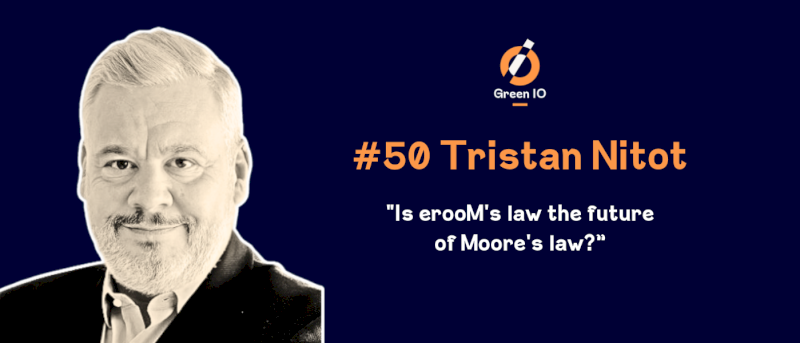Podcast
Episode 50 - Is erooM's law the future of Moore's law? with Tristan Nitot

To help celebrate the 50th Green IO podcast, Gaël Duez sits down with a long-time acquaintance and now friend Tristan Nitot, technologist and entrepreneur, to discuss the emergence of erooM’s law, which focuses on reducing the environmental footprint of digital technology.
📈Moore’s law
Gordon Moore, co-founder of Intel, realized that progress was rapid, and the number of transistors per chip was doubling approximately every two years. From this observation, there was a conscious, structural decision to continue this rate of growth. Moore’s law is not a physical law, more a projection of a historical trend into the future, a so-called experience-curve law. This strategic decision was made possible by the shrinking size of transistors over the decades and a reduction in the amount of energy consumed by each new generation.
💹Wirth’s law matters more than Moore’s law
Tristan believes that, if not dead, Moore’s law is declining, and Wirth’s law is far more relevant. Niklaus Wirth, visionary software architect, stated that “…as software slows down, the material accelerates”, or as others have since put it: ‘what intel gives you, Microsoft takes away.’ It seems that the more power we have through the technology we invent, the more functionalities we can deploy, the lazier we become as an individual, business or society.
🌱The birth of erooM’s law
By reversing Moore’s law (and Wirth’s?), focus is placed on optimizing software, not hardware. The approach becomes one of a radically organized effort for mass optimization [Effort Radicalement Organisé d’Optimisation en Masse’]. By imposing hardware boundaries, innovation increases whilst reducing the environmental footprint.
🪣‘Buckets’ of opportunities
According to Tristan there are literally buckets of opportunities to increase software optimization and reduce any environmental (not just carbon) impact. He is currently developing with the open-source community an optimization methodology which will look to find weaknesses (read under-optimized code) present in IT systems. It's a matter of language. It's a matter of libraries. It’s a matter of storage and architecture too.
🐘 Elephant in the room
Tristan acknowledges that AI is a double-edged sword. Impressed by the advancements and general deployment of recent tools, he is clearly unimpressed by the enormous amounts of resources used. And that those who develop or use such technology are not necessarily the ones paying the price. We must stop and ask ourselves what is the true value of using AI, and will it truly deliver its promises.
➕Positivity
Tristan is an optimist, and if constraints foster innovation, the physical reality of climate change and biodiversity collapse can only help us focus on the essential. By adopting erooM’s law, we will certainly become more efficient. And by collaborating with others, we can help drive this optimization within the tech industry with positive impacts for all.
❤️ Subscribe, follow, like, ... stay connected the way you want to never miss an episode, twice a month, on Tuesday! And subscribe to the Green IO newsletter here.
Join +2000 responsible readers

Green IO newsletter
Once a month, carefully curated news on digital sustainability and Green IO contents delivered in your mailbox